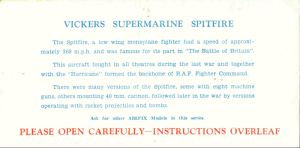
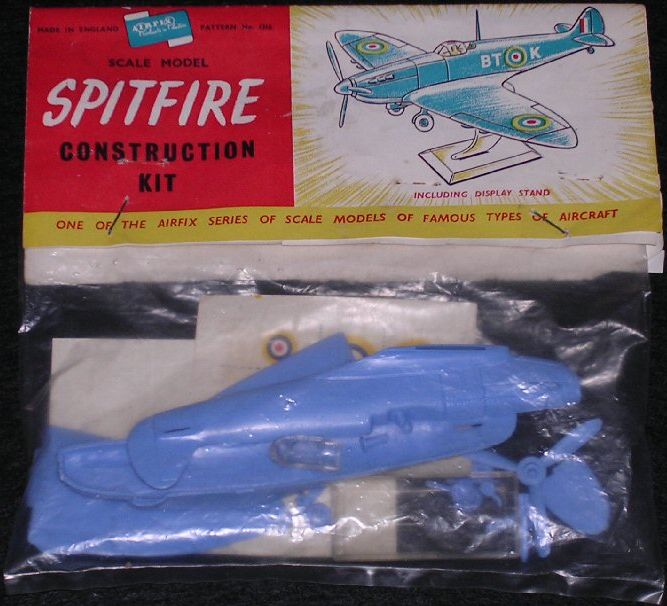
 |
Back of header. |
So it possibly was for thousands of children in Great Britain in the mid-1950's. The use of polystyrene plastic instead of cellulose acetate (which easily warped), a plastic bag to hold the parts, and a paper header which also included the instructions, allowed plastic construction kits to be cheap enough to be bought with pocket money. The small ships introduced by Airfix in 1953 or 1954 [2] (the exact year is not known) were very popular, allowing Airfix to diversify into other subjects.
Behind the Airfix Spitfire were Ralph Ehrmann, Joint-Managing Director of Airfix Products (which produced the kits) and John Gray, promoted from Chief Buyer to General Manager in 1954 [1]. Ehrmann was very interested in aircraft and history, having served with RAF Bomber Command in WWII. Gray, along with Ehrmann, also won high marks in aircraft recognition when serving in WWII [1]. The Managing Director of Airfix was Nicholas Kove, who founded the company in 1939. The name Airfix though was chosen for air-filled rubber dolls and to be near the top of ordering lists [1]. It was good chance that the name Airfix would later be perfect for aircraft construction kits, which Airfix became famous for.
Origins of Spitfire BTK
When Airfix's 1/72 scale Spitfire is compared with the Aurora (which went bankrupt in 1977) 1/48 British Spitfire from 1954 [3], it can be immediately seen that they are almost identical. They have the same number of parts, 21 all together including the stand, as well as the same inaccuracies and peculiarities. The Aurora Spitfire includes four small fictitious bombs (standard fare in Aurora fighter kits from the 1950's), two under each wing. The real Spitfire only ever carried one bomb under each wing. The Aurora kit has the pilot moulded into the fuselage halves with only the head and shoulders showing above a closed cockpit. The landing gear is also moulded into the wings, so that if the landing gear are glued, the plane has the gear both stowed and deployed at the same time! The stand has a rectangular base and curved arm. All these aspects are faithfully duplicated in the Airfix kit.
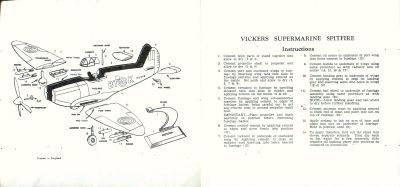 |
First issue Airfix instructions. |
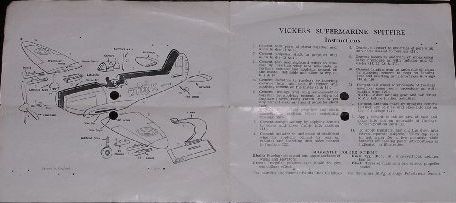 |
Second issue Airfix instructions with painting instructions. |
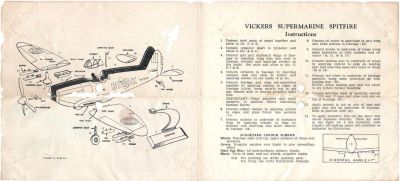 |
Later Airfix instructions with painting and dihedral angle information. |
Differences are only in the surface detail of the parts. The Aurora kit had fine rivet detail all over the wings and fuselage, whereas the Airfix kit has a smooth surface (rivet detail is only along the deeply engraved panel lines). The Aurora kit also has raised outlines of the decals on the wings and fuselage, a common practice in those days. A remnant of this can be found on the starboard side of the tail on early Airfix kits, where the outline of the red, white and blue flash can be seen. The stand has the Aurora logo replaced with "Airfix Product Made in England".
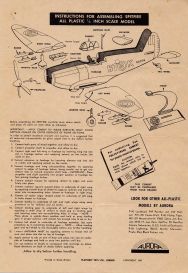 |
Aurora/Playcraft instructions from 1957 (thanks to airfixart) |
Confirmation that Airfix pantographed an American kit was given by Gray in [1]. There most likely was an arrangement between Aurora, based in Hempstead, Long Island, and Airfix at the time as the two companies were on friendly terms [1]. A strong possibility is that Airfix used an Aurora kit imported by Playcraft Toys Ltd., London. The 1/72 scale had been established by Skybirds with its wooden models and later Frog with its acetate kits in the 1930's [1]. The scale was also used for aircraft recognition models during the war. The smaller scale perfectly fitted the moulding machines that Airfix had at the time. By reducing in size the Aurora kit parts by 1/3, Airfix could obtain a 1/72 model.
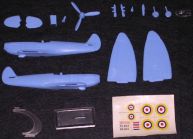 |
Airfix parts, stand and decals. Note the landing gear in the right wing. Two of the bombs are missing. (thanks to Mario Wens) |
The parts layout in the instructions are an exact copy of the Playcraft instructions, the only differences being the addition of part numbers, the removal of the Aurora logo on the base of the stand, and changing left and right wing to port and starboard wing. The written instructions are also almost exactly the same, with 14 steps and a few changes in words, for example, port for left, starboard for right, and thick for broad. The part numbers were also included, with instruction number 14 for the transfers being totally changed in wording.
What the Airfix kit had but the Aurora kit didn't was a brief history of the plane which we reproduce below:
VICKERS SUPERMARINE SPITFIRE
The Spitfire, a low wing monoplane fighter had a speed of approximately 360 m.p.h. and was famous for its part in "The Battle of Britain". This aircraft fought in all theatres during the last war and together with the "Hurricane" formed the backbone of R.A.F. Fighter Command. There were many versions of the Spitfire, some with eight machine guns, others mounting 40 mm. cannon, followed later in the war by versions operating with rocket projectiles and bombs.
The only corrections to the above were that the cannons were 20 mm with later Spitfires reaching over 450 mph. Information about wartime aircraft was still limited at the time, which may have led to these errors.
Which Mark is it?
There are no indications on either the Aurora or Airfix kit as to which mark Spitfire the kit is. The round oil cooler under the port wing, three bladed propeller, no cannons and three engine exhausts on each fuselage side indicates one of three possible types, a late model Mk.IIa, a photoreconnasiance PR.IV, or a Mk.Va.
Mk.II's are distinguished by a small bulge on the starboard engine side which the kit doesn't show. However, the kit also doesn't show the small bulges on the port engine side so this doesn't mean much. Mk.II's were fitted with Mk.III (presumably round) oil coolers from 11 April 1941 [4]. Production of the Mk.II ended in July 1941.
PR.IV's were fitted with the Merlin 45 or 46 engine which required the round oil cooler. Many PR.IV's were painted PRU Blue which matched the blue plastic the first Airfix kits were released in and the header picture of the Airfix kit. The box art of the first Aurora kits were also all in blue (other Aurora fighter kits from the 1950's were also shown in one colour, for example the ME-109 in red and FW-190 in dark green). The PR.IV though had a distinctive marking scheme quite different to the kit with low visibility blue/red B type roundels on the fuselage sides and upper wings. They also did not carry bombs but had D wings (where the machine guns were replaced with fuel tanks).
The Mk.V also used Merlin 45 and later engines. The Mk.V was the largest produced version Spitfire. The absence of 20 mm cannons on the wings though indicates an eight machine gun A wing or Mk.Va. Only 94 Mk.Va's out of 5,478 Mk.V's were produced. The first Mk.V's were built in January 1941.
Later Aurora box art showed the BTK Spitfire as a Mk.Vc with the universal C wing and two cannons (the other two cannons being blocked off), even though the kit does not have the cannons.
Markings
Another mystery about the kit are its markings. They do not match any known scheme used by Spitfires. The first mystery is the code BT-K. This was a secret code used by the RAF to indicate the squadron number (the adjoining two letters) and aircraft (single letter). Note that Airfix simply called its kit Spitfire. It was only called Spitfire BTK by model collectors, to distinguish it from latter Airfix Spitfires. Unfortunately, the codes were destroyed during and after the war, so it has been up to enthusiasts to try and work out which codes corresponds to which squadron and aircraft.
The code BT does not correspond to any squadron known to have flown Spitfires. BT was used by 252 Squadron from June 1941 flying Beaufighters, 113 Squadron from February to May 1942 flying Hudsons, and 30 Operational Training Unit from June 1942 to June 1945 flying Wellingtons, Hurricanes and Tomahawks [5].
Another possibility is that BT-K is a ringer, which is where the squadron leader has his own personal code. A famous example is JE-J used by Johnny E. Johnson on his Mk.IX Spitfire (Airfix released a kit of this in 1959 to replace the BTK Spitfire). A possible candidate is Battle of Britain ace Charles Brian Fabris Kingcombe of 92 Squadron, also nicknamed "Kingpin". He is known to have used BK on his Spitfire for Brian Kingcombe.
The second mystery is the serial number RG904, which also does not correspond to any known Spitfire. The serial number is a unique five digit number given to each aircraft in the RAF inventory. RG904 belongs to a Miles M.25 Martinet TT.1 (target tug monoplane) [6]. However, if the G was mistaken for a 6, the serial R6904 does belong a Spitfire. This is where we start to have all sorts of coincides with the above information. R6904 was in 92 squadron from 22 January 1941 to 25 July 1941 [4]. On 16 February it was sent to Rolls-Royce Hucknall where a Merlin 45 was installed so that it could be converted from a Mk.Ib with twin cannon B wings to a Mk.Vb.
So, it could be that Brian Kingcombe flew in R6904 with the ringer BT-K in 1941. Flies in the ointment though is that R6904 is known to have the code QJ-Y and that there are no cannons on the kit. Kingcombe is known to have flown in a Mk.Ib (later converted to a Mk.Vb) with code QJ-F and serial R6908.
The yellow/blue/white/red type A1 roundels for the upper and lower wing that come with the kit are also incorrect. Spitfires in 1941 had type B roundels on the upper wing. From 27 November 1940 the undersurface under the port wing was painted Night with a type A1 roundel and thin yellow outline. The roundel under the Sky painted starboard wing was blue/white/red type A. The scheme changed from 22 April 1941 with all Sky undersurfaces and type A roundels. Both these schemes have a Sky spinner and Sky fuselage band in front of the tail. Coincidentally, the second scheme is that used on latter Aurora kits.
When was the kit issued?
In 2003, Airfix issued a 50th anniversary kit of the BTK Spitfire. Up to that time, everybody had assumed that BTK was released in 1953, as shown in the Airfix kit list in [1]. The first Airfix kits used a four digit pattern number, which presumably would have followed in more or less numerical sequence. For example, Airfix's first polystyrene kit, the Golden Hind had pattern number 1264. Spitfire BTK had number 1316. In Ward's list though, Spitfire BTK was in 1953, followed by Santa Maria (1265) and HMS Shannon (1285) in 1954 and S.S. Southern Cross (1298), Cutty Sark (1309), 1911 Rolls Royce (1315) and Spitfire Mk.IX (1316) in 1955. The high pattern number of 1316 indicated that Spitfire BTK, not Spitfire Mk.IX was issued in 1955.
Further insight into this was provided in [7] when the Airfix tool log from October 1953 to October 1955 was published. This was the list used by Ward in his book. The log shows "T1124 Spitfire Kit (2 off) (14-09-1955)" and "T1125 Spitfire Stand (4 off) (20-09-1955)". No Spitfire is shown in 1953. Together with the pattern numbers, the Aurora kit being released in 1954 [3] and the near simultaneous production of a stand, this indicates that Spitfire BTK was issued in 1955, and not in 1953. So, Spitfire BTK will celebrate its 50th birthday on 14 September this year.
What happened to the kit?
Spitfire BTK was issued from 1955 to 1959 when it was replaced with Spitfire Mk.IX with the same pattern number of 1316. The first kits were issued in a swirly blue plastic, but this was soon changed to a silver plastic. The kit instructions also changed slightly. Latter issues had a hole punched in the header, the scale "1/72nd" added before "Scale Model" and painting instructions added. The final version had a small picture showing a 7 degree dihedral angle of the wings. Some of the latter kits had the rectangle stand replaced with a tear drop shaped stand. The kit was also available in the Air Fleet Gift Set, pattern number 1370, which places the set being issued around 1956. The kit had the first version header, silver plastic, a rectangular stand, and no return slip.
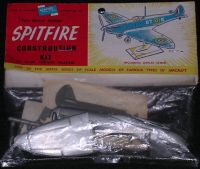 |
Second silver plastic issue. This kit has the original rectangle stand. (thanks to Mario Wens) |
1959 was not the last year the kit appeared though. The kit was released presumably in the early 1960's with plain instructions, no stand, Spitfire Mk.IX canopy, grey plastic and no reference to Airfix. The instructions show a new exploded diagram, decal instructions with type B roundels for the upper wing and type A roundels for the lower wings, and late 1941 grey/green camouflage with sky spinner and fuselage band. However, the kit decals are for BTK. It appears that the decal and painting instructions were taken from the Mk.IX kit. The instructions also state the kit is of a Mk.II Spitfire, presumably Airfix's best guess of which mark the BTK is of.
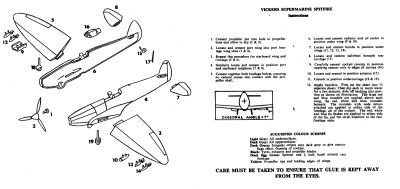 |
Frosties BTK issue instructions (thanks to Paul Grzelak) |
Other early Airfix kits (P.1127, Folland Gnat, SR.53, Jet Provost, Sea Hawk and Me 109G) also appear in this type of packaging. Except for the Spitfire BTK and Me 109G, all the other kits came with a Suncrush leaflet, 1969 date and larger box, indicating some type of promotion from Suncrush. A leaflet with the Suncrush boxes gave five choices (A, B, C, D, or E) which matches the five promotional jets. The earlier moulds of the Me 109G and Spitfire BTK, not being jets, and smaller size box probably indicates that these kits were from an earlier promotion. Boxes that the Me 109G and Spitfire BTK came in had postmarks from the Manchester postoffice. Unfortunately, the postmarks were not clear enough to indicate a date.
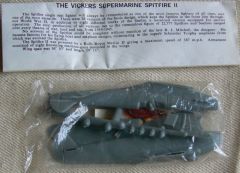 |
Frosties BTK issue parts and instructions (thanks to Sean) |
New information shows that the Me 109G and Spitfire BTK were part of Kellogg's Frosties Famous Fighters of WWII promotion. A free model could be obtained by sending in four Frosties packet tops to an address in Manchester.
The BTK mould was not in the tool bank when Humbrol bought Airfix in 1986. Most likely, it was previously sold for scrap. When the Airfix moulds were offered for sale to Palitoy in 1981, they were sold individually. If Airfix still had the BTK mould, Palitoy would have been unlikely to purchase it, due to much better Spitfire moulds being available in the Airfix tool bank.
 |
Rare boxing by German importer Plasty. The photo is of a built Spitfire BTK, but the contents is a bagged Spitfire Mk.IX, as stated on box. (thanks to Mario Wens) |
The 2003 "50th" anniversary BTK was recreated using the Airfix 1/72 Spitfire Mk.Ia from 1979 in blue plastic, a Series 5 stand, plastic bag and a recreation of the header. The pattern number was given as 1216 instead of the original 1316. The instructions did not include any painting instructions, just like the first issue. The decals were changed as well. The flashes had a corner cut off and the underwing roundels were changed from type A1 to A.
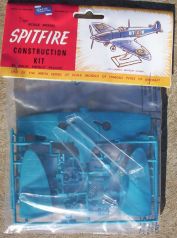 |
2003 "50th" anniversary issue. |
If you want to find an original BTK, you need to be very lucky to find one hidden away in a loft, or pay high prices on online auction sites. Expect to pay at least £100. An alternative though is to get a resin copy from Airfix's own artist, John D. Jones for only £15.
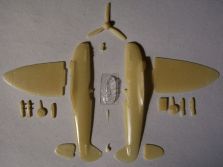 |
John D. Jones resin copy with vacformed canopy. |
Conclusions
The Airfix 1/72 Spitfire BTK was the first aircraft kit issued by Airfix in 1955. Its success led to five original aircraft kits being produced the following year. By 1959 when BTK was replaced with the all new Spitfire Mk.IX, Airfix had 13 additional aircraft kits out of the 23 new kits that year. Airfix also maintained a constant scale of 1/72 for its aircraft kits, at a time when many model companies used "box" scale, adjusting the size of the model to fit in a box. The BTK Spitfire was a crude beginning to the Airfix range of aircraft models. However, it served its purpose well, so that we can now enjoy the many aircraft and other kits produced by Airfix in the last 50 years.
Acknowledgements
The author would like to thank Richard Humm and Mario Wens for their comments on this article and Paul Grzelak and Mario Wens for their photos of Spitfire BTK's from their collection. Thanks also to Luciano Luppi for the Air Fleet Gift Set information.
References
[1] A. Ward, "Airfix: Celebrating 50 years of the world's greatest plastic kits," HarperCollinsPublishers, London, 1999.
[2] R. Humm, "Airfix kits 1949-2005," Mar. 2005.
[3] T. Graham, "Aurora Model Kits," Schiffer Books, Atglen, 2004.
[4] E. B. Morgan and E. Shacklady, "Spitfire: The history," Key Books, Stamford, 2000.
[5] M. J. F. Bowyer and J. D. R. Rawlings, "Squadron Codes 1937-56," Patrick Stephens, Cambridge, 1979.
[6] B. Robertson, "British Military Aircraft Serials 1878-1987," Midland Counties Publications, Leicester, 1987.
[7] J. Brook, "Early Spitfires," Constant Scale 15, pp. 6,7,9, Autumn 2003.
Updates
26 Mar. 2007.
2 Oct. 2020.
18 Mar. 2021. Corrected reduction of Aurora model by 2/3 to 1/3.